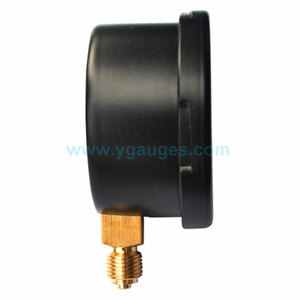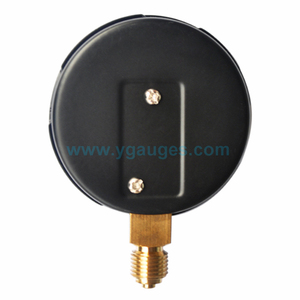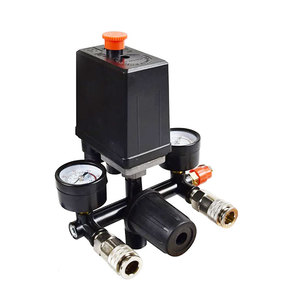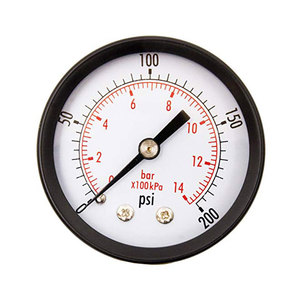
All categories
Featured selections
Trade Assurance
Buyer Central
Help Center
Get the app
Become a supplier

(1162 products available)



































In the realm of testing instruments and equipment, manifold gauge pressure regulator play a pivotal role in accurately measuring and monitoring pressure levels across various applications. These devices are essential for ensuring the functionality and safety of systems that rely on precise pressure measurements, such as pneumatic and hydraulic systems, refrigeration, and even in scientific research. manifold gauge pressure regulator are designed to provide reliable and consistent readings, making them indispensable tools in industries ranging from automotive manufacturing to aerospace engineering. Understanding the different types, features, and uses of manifold gauge pressure regulator is crucial for selecting the right instrument for specific needs.
There is a wide array of manifold gauge pressure regulator available, each suited to particular applications and environments. Common types include analog pressure gauges, digital pressure gauges, and differential pressure gauges. Analog pressure gauges, often recognized by their needle and dial interface, are valued for their simplicity and durability. Digital pressure gauges, on the other hand, offer enhanced precision and ease of reading, with capabilities of displaying measurements in various units and even recording data. Differential pressure gauges are specialized for measuring the difference between two pressure points, crucial in systems like filtration and fluid flow monitoring. Each type of manifold gauge pressure regulator is engineered to deliver specific functionalities, ensuring optimal performance in its intended application.
manifold gauge pressure regulator are designed to offer a range of functionalities that enhance their usability and reliability. They measure pressure levels in gases and liquids, providing critical data for maintaining system integrity. Features such as pressure range capabilities, accuracy ratings, and durability are vital considerations. For instance, manifold gauge pressure regulator can have pressure ranges from as low as 0-15 psi to as high as 10,000 psi, depending on the application. Accuracy ratings are typically expressed in percentage terms, with options like ±0.1%, ±0.25%, and ±0.5% being common. Durability features include corrosion-resistant materials and shock-proof casings, which ensure longevity even in harsh environments. The design and build of manifold gauge pressure regulator are tailored to meet industry-specific requirements, making them versatile tools.
The construction and materials used in manifold gauge pressure regulator are critical for their functionality and longevity. Typically, these instruments are crafted from robust materials such as stainless steel, brass, or aluminum, which offer resistance to corrosion and wear. The choice of material impacts the gauge's ability to withstand environmental factors like temperature fluctuations and chemical exposure. manifold gauge pressure regulator often incorporate components such as bourdon tubes, diaphragms, or bellows, each serving a unique purpose in measuring pressure. Bourdon tubes, for instance, are used in many analog gauges due to their ability to convert pressure into mechanical movement. Diaphragms and bellows are preferred in situations requiring sensitive measurements or low-pressure ranges. The meticulous selection of materials ensures that manifold gauge pressure regulator deliver accurate readings and have a prolonged service life.
To ensure the optimal performance of manifold gauge pressure regulator, proper use and maintenance are essential. Users should select a gauge appropriate for the pressure range and environment it will be exposed to. Regular calibration is necessary to maintain accuracy, with intervals determined by the manufacturer's guidelines or industry standards. It is also important to inspect manifold gauge pressure regulator for signs of wear or damage, such as leaks or corrosion, which could compromise their accuracy. In environments where manifold gauge pressure regulator are exposed to vibrations, shock-proof models should be considered to prevent damage. Proper storage and handling, including protection from extreme temperatures and humidity, further contribute to the longevity of these instruments. By following best practices for use and maintenance, manifold gauge pressure regulator can consistently provide reliable and precise pressure measurements.
Choosing the right manifold gauge pressure regulator requires a thorough understanding of the specific needs and conditions of your application. One crucial factor to consider is the operating environment, which influences the type of pressure gauge you should select. For example, environments with high vibration levels may necessitate the use of shock-resistant gauges, whereas corrosive environments might require gauges made from stainless steel or other resistant materials. Additionally, the pressure range that the gauge must measure should align with your system's requirements, ensuring that the gauge operates within its optimal range for accurate readings.
Another aspect to consider when selecting a manifold gauge pressure regulator is the type of display interface that best suits your needs. Analog gauges, with their traditional needle and dial, offer simplicity and ease of use, especially in settings where quick visual checks are needed. Digital gauges, however, provide enhanced precision and can display readings in multiple units, which is advantageous in complex systems requiring detailed monitoring. The choice between analog and digital interfaces should be based on your preference for usability and the level of precision required.
The accuracy of manifold gauge pressure regulator can be affected by several factors, including the gauge's design, the quality of its components, and its calibration. Regular calibration is essential to maintain accuracy, as it compensates for wear and environmental changes that could impact readings. Additionally, the materials used in the gauge's construction, such as the bourdon tube or diaphragm, play a critical role in ensuring precise measurements. Selecting a gauge with a high accuracy rating and adhering to routine maintenance schedules will help ensure reliable performance.
Calibration frequency for manifold gauge pressure regulator depends on the application and industry standards. Generally, gauges should be calibrated at regular intervals specified by the manufacturer, or based on the operational conditions they are exposed to. For gauges used in critical applications, more frequent calibration may be necessary to ensure consistent accuracy. Environmental factors such as temperature fluctuations and exposure to vibrations can also dictate the need for more regular calibration.
Yes, certain manifold gauge pressure regulator are designed to function in high-temperature environments. These gauges are typically constructed from materials that can withstand elevated temperatures without compromising their integrity or accuracy. It's important to select a gauge specifically rated for high-temperature applications to ensure it performs effectively. Additionally, considering the use of temperature compensation features can help maintain accurate readings in fluctuating temperature conditions.
Digital manifold gauge pressure regulator offer several advantages over their analog counterparts, including improved precision and versatility. They can display readings in various units, which is beneficial for applications requiring conversions between measurement systems. Digital gauges often include features such as data logging and connectivity options, allowing for integration into broader monitoring systems. These capabilities enhance the ability to track and analyze pressure data over time, providing valuable insights for optimizing system performance.
Yes, there are manifold gauge pressure regulator specifically designed to measure differential pressure. These gauges are equipped to assess the pressure difference between two points within a system, which is crucial for applications such as filtration and flow monitoring. Differential pressure gauges are built to handle the specific requirements of these measurements, ensuring accurate and reliable data. Understanding the unique features of differential gauges and selecting one that meets the demands of your system will help maintain efficient operation.